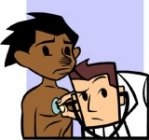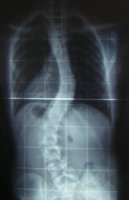
Worksheets and No Prep Teaching Resources
Reading Comprehension Worksheets
Illnesses

Illnesses
 Worksheets and No Prep Teaching Resources Reading Comprehension Worksheets Illnesses |
 Illnesses |
| edHelper's suggested reading level: | grades 4 to 6 | |
| Flesch-Kincaid grade level: | 7.02 |
|
Scoliosis
By Jennifer Kenny |

|
 1 Did you ever wonder what the doctor was looking for when checking your back during your annual exam? Or perhaps you had a similar exam completed by the school nurse in her office? That exam is known as the forward-bending test. Pediatricians use this test each year and about fifty percent of all states have public schools that use it, too. It's a check for scoliosis. It's not a paper and pencil test. Instead, the patient keeps his or her knees straight and bends over, appearing to touch his or her feet, while his or her back is examined. The nurse or doctor wants to make sure there are no abnormal spinal curves on the patient.
1 Did you ever wonder what the doctor was looking for when checking your back during your annual exam? Or perhaps you had a similar exam completed by the school nurse in her office? That exam is known as the forward-bending test. Pediatricians use this test each year and about fifty percent of all states have public schools that use it, too. It's a check for scoliosis. It's not a paper and pencil test. Instead, the patient keeps his or her knees straight and bends over, appearing to touch his or her feet, while his or her back is examined. The nurse or doctor wants to make sure there are no abnormal spinal curves on the patient. |
Create Weekly Reading Books
Prepare for an entire week at once! |
| Leave your feedback on Scoliosis (use this link if you found an error in the story) |
 |
Illnesses
|